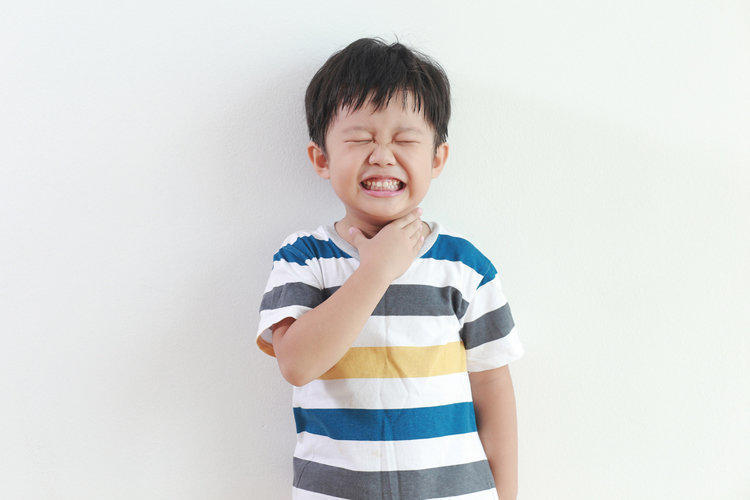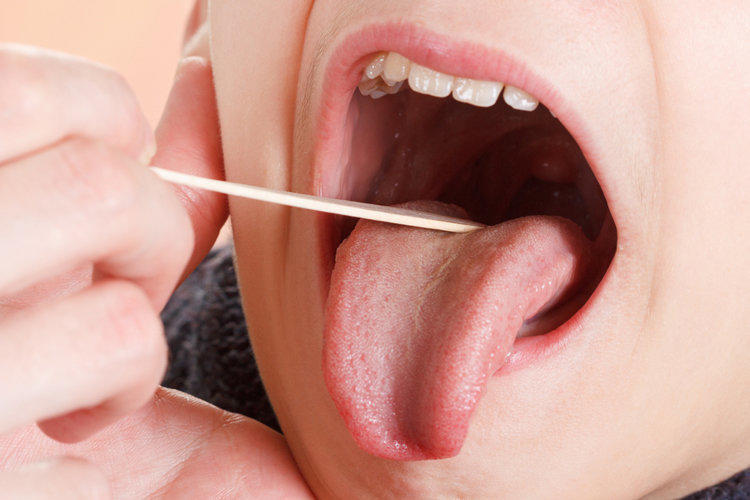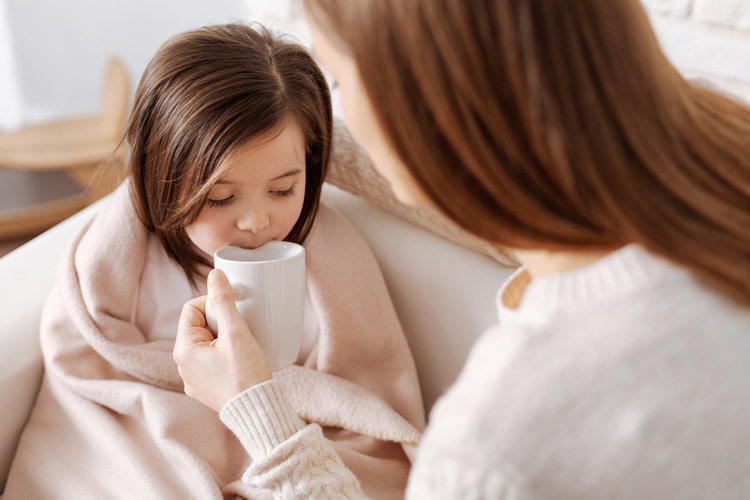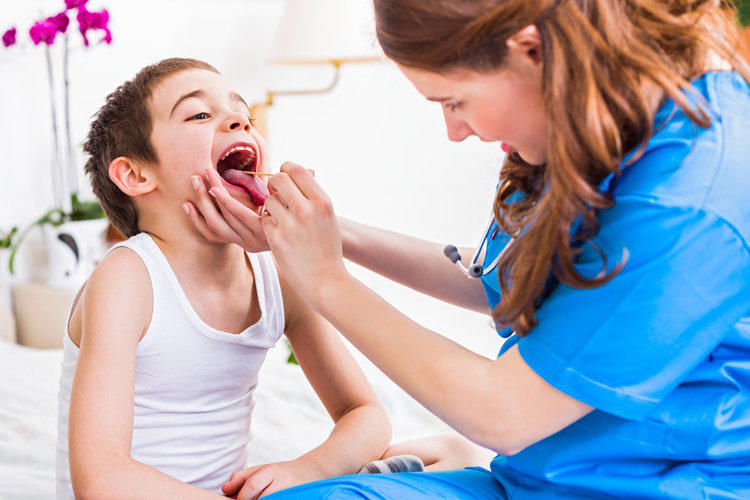- Laryngitis Classification
- Laryngitis classification according to the flow
- Classification of laryngitis according to flow intensity
- Laryngitis symptoms
- Symptoms of laryngitis in newborns and infants
- Symptoms of croup development in laryngitis
- Clinical diagnosis of laryngitis in children
- Treatment of laryngitis in children
- Care mode for laryngitis
- Medications for laryngitis
- Antibiotic use in children with laryngitis
- Physiotherapy procedures for laryngitis
- Methods of treating laryngitis in traditional medicine
- Possible complications on the background of laryngitis
- Laryngitis prophylaxis
The word laryngitis has come to us from the ancient Greek language, in which it means “larynx.” The disease itself is an inflammation of the mucous membrane of this organ, provoked by one of the following reasons:
- infection,
- supercooling or overheating,
- overstressing the larynx.
Laryngitis is primarily a childhood disease. This is due to dimensional differences in the respiratory tract of children and adults. In children, the lumen of the larynx is much less and even minor inflammation provokes its significant narrowing – the occurrence of stenosing laryngitis – laryngitis, accompanied by a narrowing of the larynx. In adults, inflammation of the laryngeal mucosa leads to a rare narrowing of the laryngeal lumen very rarely and laryngitis proceeds because of this much easier.
Laryngitis Classification
In modern medicine, there are two classifications of laryngitis: according to the shape and intensity of the flow.
Laryngitis classification according to the flow
| Laryngitis form | Description |
| Catarral | This is the simplest and most common form of laryngitis. Characterized by a set of symptoms inherent in most infectious diseases in children: dry cough, slight fever, hoarse voice. But even in this form, laryngitis requires qualified treatment, as it can lead to a temporary loss of voice and the development of respiratory failure. |
| Stenonating | As noted above, stononizing laryngitis is a disease accompanied by a significant decrease in the lumen of the larynx. Often causes breathing problems – croup. |
| Hypertrophic | Develops both independently and as a consequence of catarrhal laryngitis. Characterized by a hoarse voice with a likely loss. |
| Atrophic | Characteristic in most cases for adults. The main difference is the thinning of the mucous membrane of the larynx. |
| Hemorrhagic | Often develops with toxic flu, or with individual pathologies of the blood-forming organs. Characterized by dry cough. During the transition to wet, sputum or clotting of blood is observed in the sputum. |
| Diphtheria | Diphtheria laryngitis has a clearly marked direction of development: from the tonsils to the larynx. Visually on the mucous membranes can be observed white plaque, the detachment of which can cause clogging of the respiratory tract. Symptoms of diphtheria laryngitis resemble infections caused by streptococci. |
| Phlegmon | Purulent form of inflammation of the larynx, which is quite rare. It develops from the catarrhal form of laryngitis and is accompanied by an increase in all the symptoms. |
Classification of laryngitis according to flow intensity
| Laryngitis form | Brief |
| Acute | Suddenly, symptoms appear and develop quite sharply: discomfort in the throat (burning, painful swallowing, convulsive cough), a voice sits down. Redness and swelling of the vocal cords are observed. |
| Chronic | This form of laryngitis is manifested by the slow development of problems with the throat and vocal cords, as well as the constant feeling of needing to clear the throat. It is the result of several consecutive acute laryngitis. By the way, chronic laryngitis in adults quite often acts as an occupational disease. Singers, teachers, and those who are constantly obliged to talk to him tend to him. |

Laryngitis symptoms
The first and most striking manifestation of laryngitis in children is hoarseness. In addition, the initial stage of the development of the disease is accompanied by a dry cough, painful sensations when swallowing and difficulty breathing.
Also, the following symptoms indicate the development of laryngitis:
- red throat and swelling;
- a cough that acoustically resembles a dog barking;
- temperature increase to 37.5-38 degrees;
- feeling dry and tingling in the mouth;
- muscle spasms of the larynx.
In principle, the symptoms of laryngitis are quite similar to the development of other infectious diseases. But problems with voice and barking cough are those distinctive features that will help to determine the development of laryngitis almost unmistakably.
Symptoms of laryngitis in newborns and infants
If older children themselves can complain about discomfort in the throat, pain symptoms and other causes of the disease, then with the smallest everything is more complicated. They cannot express their problems verbally. Therefore, babies signs of laryngitis need to look out visually. Parents should be alerted to the moodiness, anxiety and general lethargy of the child, wheezing during his screaming and difficulty breathing, accompanied by whistling and noise, as well as cough and heavy discharge from the nose. All this is a reason to consult a doctor to accurately diagnose and prevent the development of complications.
Symptoms of croup development in laryngitis
Speaking of laryngitis, one can not fail to mention its complication as croup. This term refers to the respiratory pathology in children, which develops due to a significant narrowing of the laryngeal lumen. In most cases, the croup occurs at night and the attack looks rather intimidating. The child complains of difficulty breathing, the sound of which is accompanied by many unusual sounds. In some cases, cyanosis may appear on the body, which indicates insufficient saturation of blood with oxygen.
The reason for this is the development of inflammation of the larynx. In the narrowest part of this organ, the subglottic space, the lumen becomes so small that it begins to impede the breathing process. It happens at night because the accumulated mucus flows to this place, drying out there because of insufficiently humid air in the room and a sufficiently high temperature. According to statistics, croup, as a consequence of laryngitis, occurs in every second child. Therefore, when you hear a diagnosis of laryngitis from a pediatrician, you need to be prepared for the fact that already the next night the child begins to develop respiratory pathology.
The first and most correct step in this development of laryngitis will be an immediate emergency call and hospitalization of the child. Independently, the croup can be overcome by abundant moistening of air and cooling to 18 degrees of temperature in the room where the patient is located. Ideally, the child should be taken to the bathroom and open the faucet with cold water. After that, the symptoms of croup quickly begin to decline.
Doctors note that croup, despite its visual complexity and problems, does not pose a serious danger. Lack of panic in parents and simple, correct actions in most cases allow to overcome this complication even before the arrival of doctors.

Clinical diagnosis of laryngitis in children
Diagnosis and treatment of laryngitis are carried out by a pediatrician who, if necessary, consults with an otolaryngologist. The complex clinical diagnosis of this disease consists of such studies:
- Analysis of the history and complaints of the patient.
- General examination of the child, designed to identify changes in the size of the lymph nodes and the presence of prerequisites of pain in the larynx.
- Visual inspection of the larynx with an endoscope, which reveals a narrowing of the laryngeal lumen, the presence of redness and swelling, as well as purulent and mucous deposits in the larynx.
- Intake of a smear from the laryngeal mucosa, which allows you to identify the causative agent of an infectious disease.
- Complete blood count to indicate the origin of laryngitis: viral or bacterial.
On the basis of all these data, the pediatrician makes the final diagnosis, determines the tactics of treatment and decides on the need for hospitalization of the child. Inpatient treatment for laryngitis is necessary in the following cases:
- the presence of respiratory pathologies, narrowing of the larynx, which may soon cause croup;
- laryngitis in complex forms;
- patient has allergies, diseases of the central nervous system and other conditions that complicate the development of laryngitis.
Treatment of laryngitis in children
The treatment of laryngitis is based on three main areas:
- child maintenance mode,
- drug therapy
- physiotherapeutic procedures.
Care mode for laryngitis
When inflammation of the larynx, the child must implement a certain lifestyle. The main thing is bed rest and the maximum limitation of voice activity. It is clear that it will not be possible to make the child remain silent for a week, but you need to try so that, if necessary, he speaks in a whisper. At the same time, the larynx is restored fairly quickly, and the likelihood of development of irreparable defects of the vocal cords, which are still being formed in a child, tends to zero.
The air in the room where the child is located should be cool and important. The optimum temperature is +18 Celsius degrees, humidity – 70 percent. To ensure these indicators, we ventilate the room, if necessary, reduce the intensity of the heating devices and use a humidifier.
Food during laryngitis should be such as not to irritate the throat. Not sour, not hot, not cold. The throat needs full rest. Drinking well, also not annoying, should be as copious as possible. It allows you to quickly go through the stage of dry cough and reduce the effect of toxins on the body.

Medications for laryngitis
When laryngitis in children, in most cases, a complex of drugs is used to alleviate the symptoms of the disease. Conventionally, they are divided into four groups of symptoms, which they eliminate:
| Medication Group | Commercial names and price | Direction |
| Antihistamines | Zyrtec, Zodak, Parlazin, Fenistil. | The effect of antihistamine medicines is aimed at reducing the degree of swelling of the laryngeal mucosa in children, as well as calming the general condition of the child. Most of these products can be used even for the smallest patients. Fenistil is even prescribed to newborns, Zyrtec children from six months, Zodak from a year, and Parlazin from six years. |
| Expectorants and cough removal medicines | Lasolvan, Gerbion, Ambrobene. | The appointment of this group of funds should be carried out on the recommendation of a doctor. Depending on the individual characteristics of the small patient and the nature of the flow of laryngitis, he will select a drug that will have the best effect without adverse effects on the body. |
| Preparations for relieving discomfort in the throat | Strepsils, Faringosept, Lyugol. | Medicines of this group are produced mainly in the form of syrups and lozenges. It relieves pain when swallowing, has an antiseptic and antibacterial effect. |
| Antipyretics | Nurofen, Paracetamo. | In cases where laryngitis is accompanied by fever, the child should be given medication to reduce it. Traditional Nurofen and Paracetamol are most effective here. However, as with most diseases of this nature, it is not recommended to bring the temperature down to 38 degrees. |
Antibiotic use in children with laryngitis
Antibiotics in children’s laryngitis treatment regimen are rarely used. The main reasons for their appointment are the bacterial nature of the inflammatory process and the high level of intoxication of the child’s body. At the same time, laryngitis of bacterial origin is a rather rare phenomenon, as is the use of antibiotics for this disease.
Precedents are also known when antibiotics were prescribed for laryngitis, even without the necessary prerequisites. This is done for reinsurance from the development of complications. But in medicine, such a move is considered redundant, and the benefit of it does not compensate for the likely harm.
If the prerequisites for the use of antibiotics for laryngitis in a child are present, then in most cases the drugs used are characteristic of other infectious diseases: penicillins, cephalosporins and macrolides. The last two groups are used for individual intolerance to penicillin drugs, or when there are other reasons for this.
Physiotherapy procedures for laryngitis
It has been noted above that with laryngitis the most important factor in recovery is moist air. That is why inhalation is recommended for this disease. They need to be carried out on special equipment in a hospital, or on a home inhaler. Breathing steam, especially a child, is not necessary, as this can lead to burns of mucous membranes.
Of the preparations for inhalation with laryngitis, a solution of soda (a teaspoon per glass of water), Borjomi and Essentuki mineral waters, herbal tea with chamomile and mint are recommended. Of the drugs for inhalation are often recommended Lasolvan and Sinupret.
Inhalation of children with laryngitis is prescribed twice a day. The procedure should be carried out between meals. It is recommended during the inhalation and half an hour after it not to talk at all, so that the effect was maximum.
Of the other physiotherapy procedures for laryngitis in children under inpatient treatment are: UHF therapy, electrophoresis with effects on the larynx, ultraviolet irradiation and microwave exposure. All these procedures have a positive effect on the course of laryngitis, effectively enough removing the main symptoms of the disease.
Methods of treating laryngitis in traditional medicine
Traditional medicine for such infections are also aimed at overcoming its symptoms. The most effective method is gargling. To do this, use decoctions of plants that have a natural expectorant effect, as well as antiseptic and anti-inflammatory effects. In particular, boiled beet juice is effective for gargling. In addition, it is useful to gargle with laryngitis honey dissolved in boiling water (teaspoon per glass of water). After cooling the resulting product, you need to use it three times a day.
It is useful to apply other methods of warming in acute laryngitis. In particular, children often make mustard baths for their feet and put mustard plasters on their backs, and put compresses on the neck area for warming up for the night. Using these procedures, the recovery of the body is much faster, and the symptoms of laryngitis have less discomfort.
But you need to remember that medical treatment of the disease is necessary and folk remedies should be used only as a supplement.
Possible complications on the background of laryngitis
Late treatment for laryngitis or its absence, as well as incorrectly chosen treatment tactics for laryngitis can cause the development of very serious complications. Acute laryngitis often develops its chronic form, and the following consequences may flow from it:
- narrowing of the laryngeal walls and the development of respiratory pathologies;
- problems with vocal cords that can lead to a complete loss of voice;
- vocal cord tumors: granulomas, polyps;
- benign tumors of the larynx;
- laryngeal cancer.
And if laryngeal stenosis in chronic laryngitis develops in almost 90 percent of patients, the remaining possible consequences are quite rare. Only a complete lack of adequate therapy and a number of matched aggravating factors can lead to them.
In addition, the complications of laryngitis also include its development in purulent forms. And they are often characterized by the following complications:
- inflammation in the chest cavity (mediastinitis),
- lung abscesses (a pus-filled cavity is formed in the lung),
- sepsis (bloodstream infection),
- purulent inflammations of the neck tissues (phlegmon).
It is the purulent forms of laryngitis that are considered the most unpleasant and difficult in stopping, and everything must be done to prevent their development.
Laryngitis prophylaxis
In fact, preventive procedures, specifically against the occurrence of this infectious disease, do not exist. Absolutely everyone is exposed to infections. But, the task of parents is to make the protective functions of the child’s body as strong as possible. First of all, we are talking about hardening. Wash your face with cool water, walk a lot, regardless of the weather, instill in children a love for sports. This will allow the body to independently confront many diseases.
In addition, a proper and healthy diet is especially important. In food for children, and for adults, healthy, natural products should prevail: vegetables, meat, seafood, dairy products. At the same time, it is necessary to limit the use of so-so-loved chips with soda, sweets and other things.
Another important factor in confronting infectious diseases is the correct microclimate in the room where the child lives. The room should be fresh: do not overheat the air to 22-25 degrees. 18 degrees is enough for a comfortable stay. In this case, you will forget about the sleepiness of their children. They will be more active time.
At the same time, it is necessary to control the humidity of the air. Few people attach importance to this nuance, but a device for measuring humidity and for humidifying the air should be in every children’s room, and not only a children’s one. Humidity at the level of 60-7 percent, coupled with the temperature indicated above, is the key to successful prevention of many childhood diseases.
Yes, no method of prevention against laryngitis can give you guarantees, but all these actions will increase the overall health of your children and save them from many problems.





